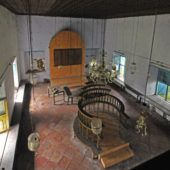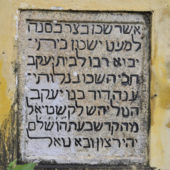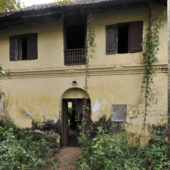The Parur Synagogue is an archetypical example of the local thachusasthra style. As with other Cochin synagogues, it is made up of not one building but a collection of parts forming a distinct compound.
Parur Synagogue is located in Parur, Ernakulum near the island of Cochin. It was established by the Bene Israel Jews which is perhaps the only sect of Judaism who have not been subjected to anti-Semitism. Having lived harmoniously with their Indian neighbors for over 2,000 years, they have been free to worship and practice Judaism, and to live as a community. They have been fully included into Indian society, yet have still retained their “separateness.”
The Bene Israeli claim to be direct descendents from the lost “ten tribes” of Israel. Biblical history relates that these ten tribes formed the Kingdom of Israel, which were exiled from their capital, Samaria, by the Assyrian King, Shalmaneser and subsequent kings from 722 BCE onwards. Other Bene Israeli believe that their ancestors escaped from Israel by sea in 175 BCE during the reign of Antiochus Epiphanes (prior to the events leading to Hannukah). Legend recounts that on the sea voyage from Israel, the forefathers of the Bene Israeli were shipwrecked and washed ashore the Konkan coast, south of Bombay. There were only fourteen survivors, seven women and seven men. They buried their dead near the village of Nawgaon, which later became the foundation of the first Bene Israel cemetery. The surviving Bene Israeli were offered to settle permanently in the Konkan villages. They adopted Hindu names similar to their first names, but added “-kar” onto their surnames, often indicating where they came from, for example: Penkar came from the village of Pen.
Many Bene Israeli at that time worked as oil pressers. To outsiders, the Bene Israeli did not appear different to others Indians, with the exception that they observed the Sabbath, celebrated major festivals, circumcised their sons and performed most of the prescribed Biblical offerings. Most of the prayers were forgotten, except for the “Shema Israel…” (Heal, O Israel…”). When David Rahabi arrived, the Bene Israel came into contact with the other Jews. It is unclear as to whether he was an 18th century Cochin Jew, or whether the Bene Israel tradition that records his arrival as far back as 1,000 CE is correct. Either way, he was a Cochin Jew who helped promote unity between all Indian Jews. He allegedly inspired them to begin celebrating Shavuot, Sukkoth, as well as, more minor feasts and fasts, which they had not been observing prior to their relationship with him.
By the 19th century, Cochin Jews were involved in training the Bene Israel religious leadership: teachers, cantors and ritual slaughterers. In 1745 the Divekar family, were the first Bene Israel family to settle in Bombay (now known as Mumbai), where religious freedom was ensured by the British. Their five sons were employed by the East India Trading Company. In 1796, additional Bene Israel families followed the Divekar family and moved to Bombay. By the end of the 19th century, the Bene Israel workers in Bombay were performing white-collar work, and employed as doctors, lawyers, writers, architects, professors, teachers, nurses, secretaries, social workers, civil servants and skilled workers in factories and workshops. Bene Israel families began to emigrate from as far as Burma and Aden to Bombay. The Bene Israel population grew from 6,000 in the 1830s to 10,000 by the turn of the century. In 1948 there were 20,000 Bene Israel in India; however, this number decreased to 16,000 as a result of emigration to Israel. Today, there are less than 5,000 Jews in India, most of whom are Bene Israel, due to further numbers emigrating not only to Israel, but also to the United States, Britain, Canada and Australia. At the beginning of the 21st century over 60,000 Bene Israel lived in Israel.
The synagogues in Kerala have similar architectural features: a central bimah on a concrete or stone base, the Aron Kodesh on the western wall, a balcony upstairs against the eastern wall with a second tivah (reader’s desk) used by the reader on certain holidays. Behind the balcony is the women’s gallery with a stairway leading up to it, usually from outside the building.
The Parur Synagogue is comprised of seven structures. For years, visitors to the Synagogue would be led by a Christian neighbor with a rusty key, into the gatehouse. They would make their way across a dim, empty hall flanked by rooms including one, which served as a Hebrew class. They would then tread carefully on a path through a garden full of snakes to the Synagogue. They would first be met with a large stone plaque inscribed in Hebrew in 1616. The exterior of the buildings is covered with a combination of whitewashed chuman (polished lime) over laterite (a soft reddish-brown local stone). This is all typical of synagogues in Kerala. The deep-eaved roofs are covered with terracotta tiles. Inside the two-story prayer-room, dusty chandeliers and wooden rosettes on the ceiling would testify to the charm and beauty of this Synagogue.
Constructed in 1615, tradition holds that it was built on the ruins of an ancient synagogue, dating back to 1165. The entrance doors feature exquisite carvings, a style repeated at the Mala Synagogue. The original bimah and Aron Kodesh were shipped to Israel in 1995. Reconstructions of the originals have been installed in their place. The bimah is circular, with a five-tiered medium wood balustrade enclosure and one opening. The Aron Kodesh is simply constructed in brick and arched in shape. The balcony, its medium wood balustrade with outward bulge in the center for the secondary tivah, supporting columns and beams are beautifully painted and gilded. The steps leading to the balcony have unusual flat supports as railings. Inside, beautiful wooden latticed screens were once used. The ten, large shuttered windows that adorn the walls represent The Ten Commandments.
The floor, benches, doors, windows, and roof tiles have all required repair. Renovation of the Synagogue began in 2009 and is to be completed in Spring of 2011. Mr. Joseph Simon is the custodian of the Synagogue and he and his small family live in the front entrance rooms.







